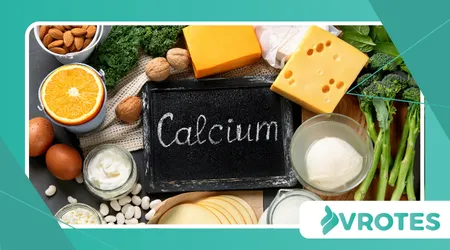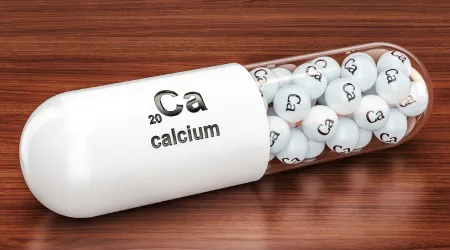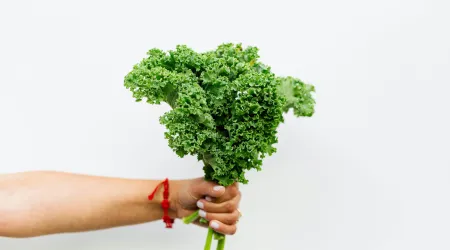Top 7 Calcium-Rich Foods to Protect Bone Health in Menopause

Calcium-rich foods are essential allies for women experiencing menopause, a unique phase marked by profound hormonal shifts and increased vulnerability to bone loss.
As estrogen production declines, the body’s natural defense against osteoporosis weakens, making the right dietary choices more crucial than ever.
The urgency to prioritize bone health isn’t just about numbers on a lab report—it’s about maintaining independence, mobility, and quality of life through the decades ahead.
Menopause often arrives quietly, but its impact on bone density can be dramatic.
According to the International Osteoporosis Foundation, women can lose up to 20% of their bone mass within five to seven years after menopause begins.
This statistic isn’t just a distant possibility; it’s a reality that affects millions of women globally, leading to fractures, chronic pain, and diminished vitality.
The question isn’t whether bone health matters, but how menopausal women can take proactive, evidence-based steps to protect themselves.
Understanding the role of calcium-rich foods goes beyond memorizing a list of ingredients. It’s about integrating smart nutrition into daily routines, making each meal an opportunity to invest in your future.
The challenge is real: many women struggle to meet the recommended daily intake of 1,200 mg of calcium after age 50, especially as dietary preferences and digestive sensitivities evolve.
So, how can you ensure your plate supports your bones, your energy, and your sense of well-being?
Let’s explore, in detail, the top seven calcium-rich foods that can make a meaningful difference in bone health during menopause.
Along the way, you’ll discover practical tips, real-life examples, and the science behind every recommendation—because protecting your bones is about more than just what you eat; it’s about how you live.
The Crucial Role of Calcium During Menopause

Calcium is the fundamental building block of strong bones, but its importance intensifies during menopause.
As estrogen levels drop, bones lose their ability to retain calcium efficiently, accelerating the risk of osteoporosis and fractures.
The North American Menopause Society emphasizes that adequate calcium intake, paired with vitamin D, can slow bone loss and reduce fracture risk significantly.
Yet, many women underestimate how quickly bone density can decline. A recent review published by the National Institutes of Health highlighted that nearly 50% of postmenopausal women will experience an osteoporotic fracture in their lifetime.
This isn’t just a statistic—it’s a call to action for women to reassess their daily habits and nutritional strategies.
Practical steps can make a real difference. For instance, starting your morning with a calcium-rich breakfast sets the tone for the day.
Consider a bowl of fortified cereal with low-fat milk or a smoothie with yogurt and leafy greens.
These choices not only deliver a calcium boost but also provide protein and other vital nutrients that support muscle and bone synergy.
It’s also important to understand that calcium isn’t absorbed equally from all foods. The presence of vitamin D, the food matrix, and even cooking methods can influence how much calcium your body actually utilizes.
For example, steaming broccoli enhances its calcium bioavailability, while pairing dairy with vitamin D-rich foods like salmon or eggs can further enhance absorption.
Beyond diet, lifestyle factors such as regular weight-bearing exercise and limiting sodium and caffeine intake also play roles in optimizing bone health.
Menopausal women should view bone protection as a holistic endeavor, where nutrition, movement, and mindful habits converge.
Yogurt: The Gut-Friendly Powerhouse

Among calcium-rich foods, yogurt stands out for its impressive calcium content and its positive impact on gut health.
One cup of plain, low-fat yogurt provides approximately 450 mg of calcium—over a third of the daily requirement for women over 50.
But yogurt’s benefits extend beyond bone health; its live probiotics support digestion and immune function, both of which can be compromised during menopause.
Incorporating yogurt into your daily routine is both simple and versatile. Start your morning with a parfait layered with Greek yogurt, fresh berries, and a sprinkle of chia seeds.
This not only delivers a substantial calcium boost but also provides antioxidants and healthy fats, supporting overall wellness.
For those with lactose intolerance, lactose-free yogurts or plant-based alternatives fortified with calcium can be excellent substitutes.
A practical example: Ana, 53, struggled with digestive discomfort after menopause.
By switching to probiotic-rich yogurt and adding it to her breakfast, she noticed improved digestion and higher energy levels.
She also met over a third of her daily calcium needs before noon—a small change with significant benefits.
Yogurt can also be used as a base for savory dips, salad dressings, or even as a topping for baked potatoes, making it easy to incorporate into various meals.
Opt for unsweetened varieties to avoid excess sugar, and check labels for live cultures and calcium content to maximize benefits.
For women who prefer plant-based diets, many almond, soy, and coconut yogurts are now fortified with calcium and vitamin D.
Just be sure to choose brands that offer at least 200 mg of calcium per serving, and pair them with fruits or seeds for a balanced snack.
Leafy Greens: More Than Just a Salad
Leafy greens like kale, bok choy, and collard greens are often overlooked in the conversation about calcium-rich foods, yet they offer highly absorbable forms of calcium.
Unlike spinach, which contains oxalates that hinder calcium absorption, kale and bok choy provide calcium that the body can utilize efficiently.
For example, a cup of cooked kale contains about 180 mg of calcium, making it a valuable addition to any meal.
Incorporating leafy greens into your diet doesn’t have to be monotonous. Sauté kale with garlic and olive oil for a flavorful side dish, or add chopped bok choy to stir-fries and soups.

These greens can also be blended into smoothies or baked into chips, offering variety and convenience.
Consider the case of Maria, who began adding two servings of leafy greens to her daily meals after her doctor warned her about declining bone density.
Within six months, she not only improved her calcium intake but also enjoyed better digestion and increased energy.
The versatility of leafy greens allowed her to experiment with new recipes and flavors, keeping her meals interesting and nutrient-rich.
Leafy greens also provide vitamin K, magnesium, and fiber, all of which play supportive roles in bone health and overall well-being.
For women concerned about sodium intake, these vegetables offer a low-sodium, high-nutrient option that complements a heart-healthy diet.
Cooking methods matter, too. Lightly steaming or sautéing greens preserves their calcium content while making them easier to digest.
Pairing them with a squeeze of lemon juice can enhance flavor and nutrient absorption, making each meal both delicious and beneficial.
Cheese and Dairy: Versatile Calcium Sources
Cheese, especially hard varieties like cheddar and Swiss, is a classic example of calcium-rich foods that fit easily into a variety of dishes.
One ounce of cheddar cheese contains about 200 mg of calcium, while Swiss can offer up to 270 mg per ounce.
Dairy products also provide protein, phosphorus, and vitamin D, all of which are essential for bone strength and muscle maintenance.
Adding cheese to your meals can be both enjoyable and strategic. Sprinkle shredded cheese over salads, melt it into omelets, or pair it with whole-grain crackers for a satisfying snack.
For women who are lactose intolerant, aged cheeses like Parmesan and Swiss contain less lactose and are often better tolerated.
A practical scenario: Lucia, 55, found that including a slice of cheese with her afternoon snack helped curb cravings and provided a steady source of calcium.
This simple habit contributed to her bone health while supporting her weight management goals.
Dairy’s benefits aren’t limited to cheese. Milk and yogurt remain reliable sources of calcium and can be incorporated into smoothies, soups, or even used as a base for creamy sauces.
For those who avoid dairy, fortified plant-based milks such as almond, soy, or oat milk offer comparable calcium levels—just be sure to choose unsweetened, fortified varieties.
It’s important to pay attention to portion sizes and sodium content, especially with processed cheeses.
Opt for natural, minimally processed options whenever possible, and balance your intake with plenty of fruits, vegetables, and whole grains.
Plant-Based Alternatives: Almonds, Tofu, and Sesame Seeds
For women seeking non-dairy calcium-rich foods, plant-based options like almonds, tofu, and sesame seeds are invaluable.
Almonds provide about 75 mg of calcium per ounce, along with vitamin E and healthy fats that support heart health.
Tofu, particularly when set with calcium, can deliver up to 400 mg per half-cup serving, making it a powerhouse for both calcium and protein.
Incorporating these foods into your diet can be both creative and satisfying. Add sliced almonds to oatmeal or salads, blend tofu into smoothies or stir-fries, and sprinkle sesame seeds over roasted vegetables or grain bowls.
These simple additions can significantly boost your daily calcium intake without relying on dairy.
A real-world example: Carla, a vegan in her early 50s, worried about meeting her calcium needs after menopause.
By rotating tofu, almond butter, and sesame seeds into her weekly meal plan, she consistently reached her calcium targets and enjoyed a diverse, flavorful diet.
Sesame seeds, though small, pack a powerful nutritional punch. Just one tablespoon contains 88 mg of calcium.
Tahini, a paste made from sesame seeds, can be used in dressings, dips, or sauces, providing both flavor and bone-strengthening benefits.
It’s worth noting that some plant-based foods contain compounds like phytates and oxalates, which can interfere with calcium absorption.
However, soaking, sprouting, or lightly roasting nuts and seeds can reduce these compounds and enhance nutrient availability.
For those who prefer convenience, many plant-based milks and yogurts are now fortified with calcium and vitamin D.
Always check labels to ensure adequate fortification, and aim for products that provide at least 200 mg of calcium per serving.
Practical Strategies for Meeting Your Calcium Needs
Reaching the recommended 1,200 mg of calcium daily may seem daunting, but with thoughtful planning, it’s entirely achievable.
Start by spreading your calcium intake throughout the day, as the body absorbs smaller amounts more efficiently than large doses all at once.
Here’s a practical meal plan to illustrate how easily you can meet your calcium goals:
- Breakfast: Greek yogurt with sliced almonds and berries (450 mg + 75 mg)
- Lunch: Kale and chickpea salad topped with sesame seeds (180 mg + 88 mg)
- Snack: Whole-grain crackers with Swiss cheese (270 mg)
- Dinner: Tofu stir-fry with broccoli and bok choy (400 mg + 180 mg)
- Evening: Glass of fortified soy milk (300 mg)
Total: 1,943 mg (well above the target, but within safe limits)
Pairing calcium sources with vitamin D-rich foods, such as salmon or fortified orange juice, further enhances absorption.
Regular weight-bearing exercise, like walking or resistance training, stimulates bone formation and complements nutritional strategies.
Consider this analogy: Think of your bones as a retirement fund. Every serving of calcium-rich foods is a deposit, while menopause accelerates withdrawals.
The more you invest early and consistently, the greater your security and independence as you age.
For additional guidance and up-to-date recommendations, consult resources like the National Osteoporosis Foundation and the The Menopause Society.
Conclusion: Invest in Your Bone Health Today
Menopause is a pivotal moment—a time to prioritize not only your bones but your overall well-being.
By embracing calcium-rich foods and making informed choices, you empower yourself to maintain strength, mobility, and independence well into the future.
The journey doesn’t have to be overwhelming. Start with small, sustainable changes: add a serving of yogurt to breakfast, toss leafy greens into your lunch, or sprinkle sesame seeds over your dinner.
Each choice is a step toward stronger bones and a more vibrant life.
Remember, bone health isn’t just about avoiding fractures—it’s about preserving your freedom to move, explore, and enjoy every stage of life. Are you investing enough in your bone bank today?
For more in-depth information and practical tools, visit the International Osteoporosis Foundation and the National Institutes of Health Office of Dietary Supplements.
Your bones are the foundation of your health. Nurture them with care, intention, and the power of calcium-rich foods—and let every meal be an act of self-care and empowerment.
Frequently Asked Questions
1. How much calcium do I really need after menopause?
Women over 50 should aim for at least 1,200 mg of calcium daily, ideally from a variety of food sources.
2. Can I get enough calcium if I’m lactose intolerant or vegan?
Absolutely. Fortified plant milks, tofu, leafy greens, almonds, and sesame seeds are excellent non-dairy sources.
3. Is it better to get calcium from food or supplements?
Food sources are preferred due to better absorption and additional nutrients. Supplements can help if dietary intake is insufficient—consult your healthcare provider.
4. What else supports bone health besides calcium?
Vitamin D, protein, magnesium, and regular weight-bearing exercise all play crucial roles in maintaining bone strength.
5. Are there risks to consuming too much calcium?
Yes. Excessive calcium (over 2,500 mg/day) can lead to kidney stones and other health issues. Balance and moderation are key.
6. How can I improve calcium absorption?
Pair calcium-rich foods with vitamin D sources, limit sodium and caffeine, and spread intake throughout the day for optimal absorption.
.
